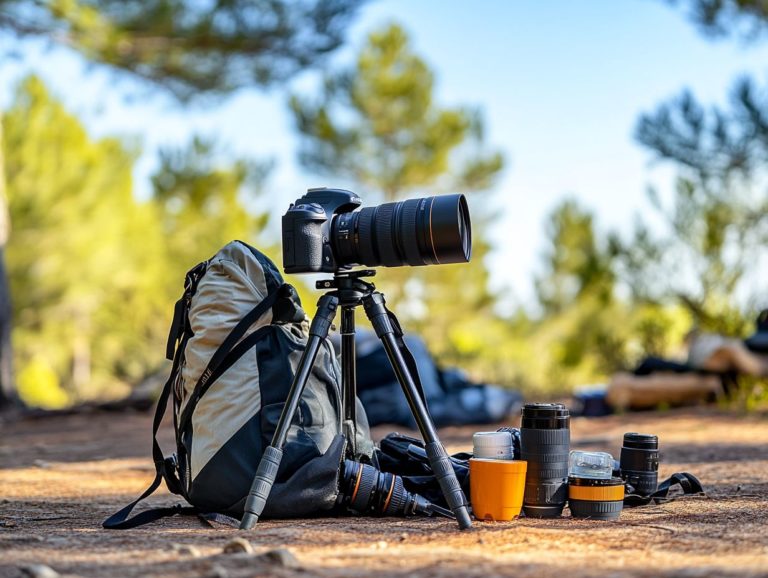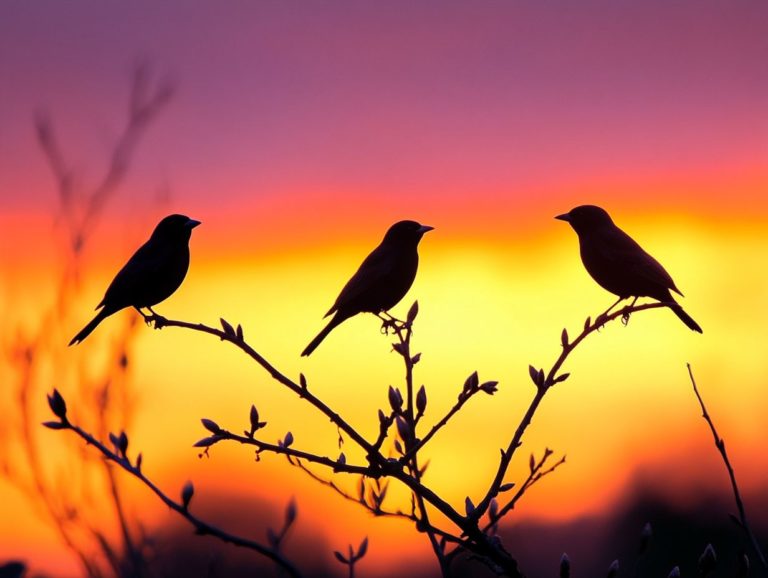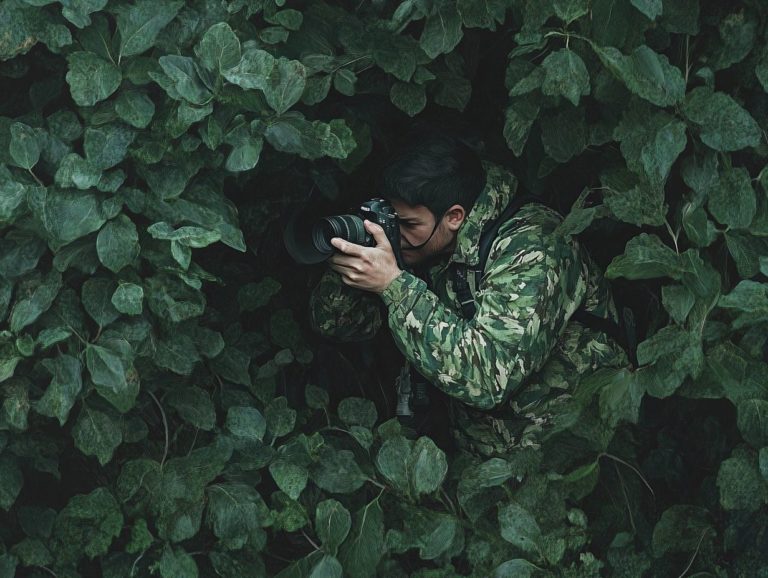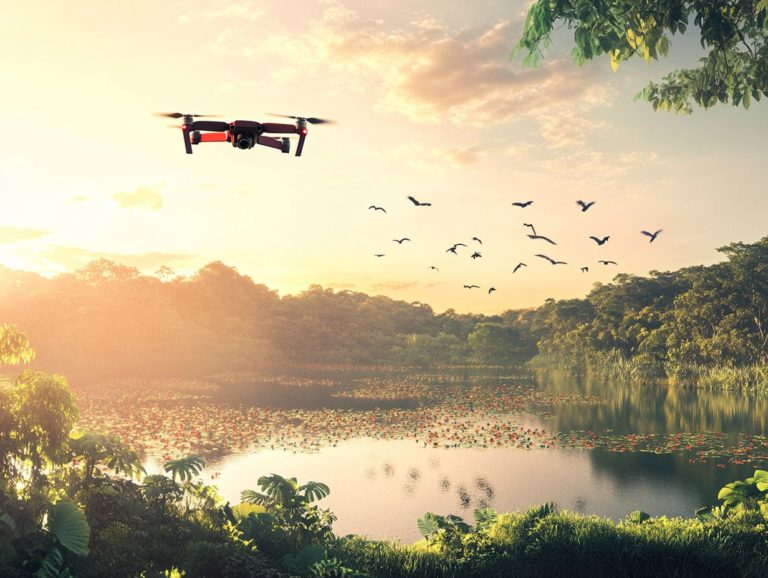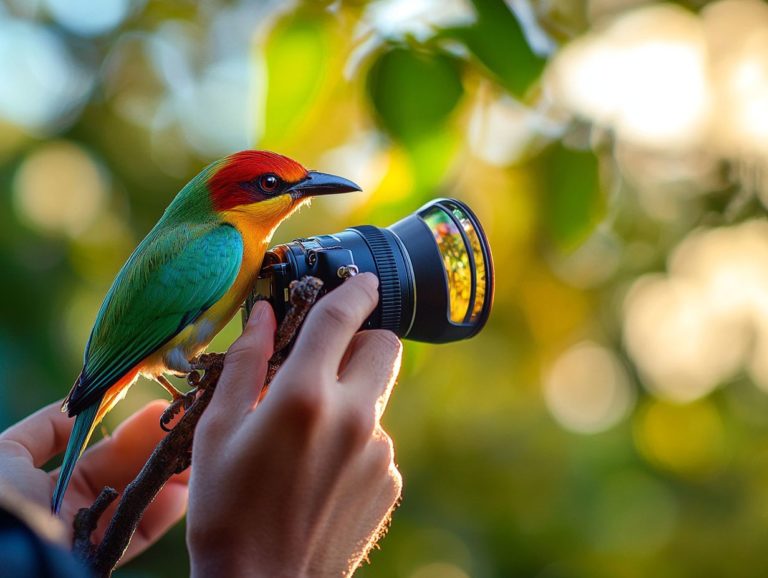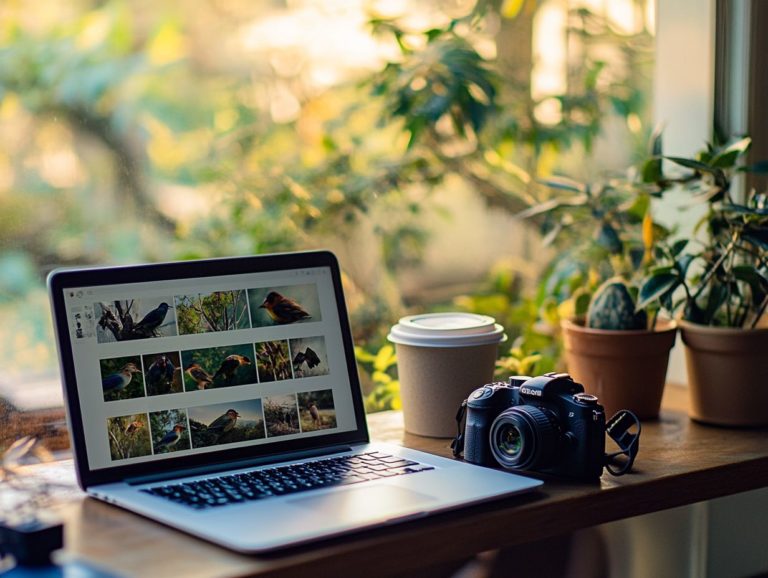Wildlife Photography: Tips for Beginners
Wildlife photography offers you a captivating glimpse into the lives of animals within their natural habitats. However, it requires more than just a sharp eye and a passion for nature; essential fieldcraft skills are also crucial.
This guide is here to equip you with essential tips for beginners as you embark on your photographic journey. You’ll get insights on everything from selecting the right gear to mastering effective techniques.
Get ready to discover the best cameras and lenses that will transform your wildlife photography! You ll learn how to compose your images beautifully and find the ideal locations and times to capture wildlife in action.
This guide also provides valuable insights on how to approach wildlife safely and respectfully, including understanding animal behavior and local knowledge. Whether you re a novice or seeking to enhance your existing skills, this resource will pave the way for an exhilarating adventure into the world of wildlife photography.
Contents
- Key Takeaways:
- Essential Gear for Wildlife Photography
- Techniques for Capturing Great Shots
- Locations and Timing for Wildlife Photography
- Tips for Getting Close to Wildlife
- Frequently Asked Questions
- What is wildlife photography?
- What are some tips for beginners in wildlife photography?
- What equipment do I need for wildlife photography?
- How important is patience in wildlife photography?
- What are some techniques for capturing great wildlife photographs?
- Is it ethical to manipulate wildlife for a photograph?
Key Takeaways:
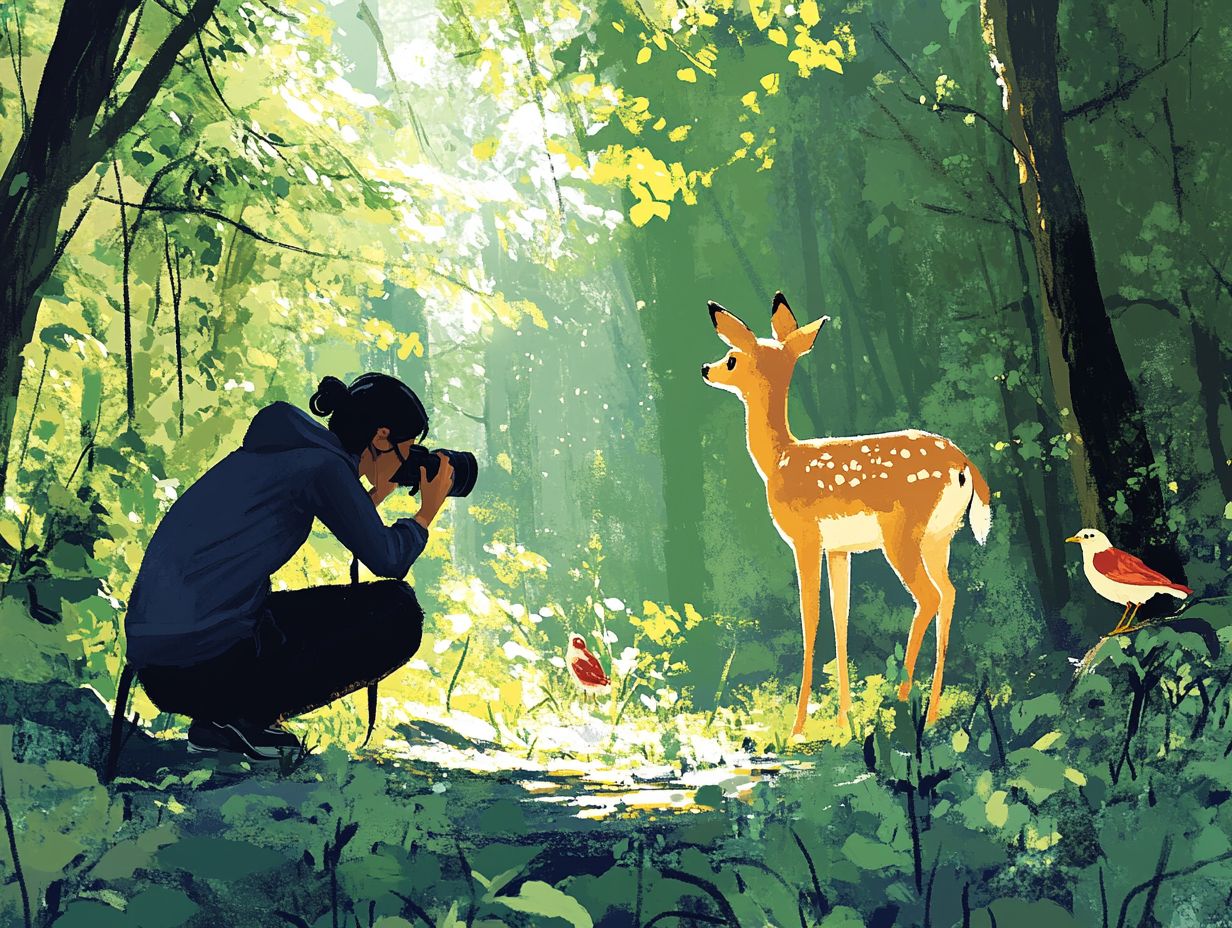
- Get the right gear now to capture breathtaking wildlife shots! A quality camera and lens are essential, along with accessories like a tripod and teleconverter.
- Learn the techniques that will elevate your photography immediately! Composition and lighting are crucial; experiment with different angles and lighting for unique images.
- Explore the best locations to maximize your wildlife encounters! Research the best places for wildlife photography and know when to shoot for optimal lighting and animal activity. Be patient and respectful to get close to wildlife.
What is Wildlife Photography?
Wildlife photography is an enchanting realm of nature photography that allows you to capture the essence of animals in their natural habitats. This genre demands not just a sharp eye for composition but also a profound understanding of animal behavior and the ecosystems these creatures call home.
You may find yourself in remote locales, like the Chiricahua Mountains of Arizona or the sprawling landscapes of Canada. You ll patiently await that perfect moment, perhaps a moose grazing at dawn or a Bald Eagle soaring majestically overhead, or even observing polar bears in their natural environments.
But it s not just about aesthetics; wildlife photography plays a vital role in conservation, illuminating the beauty and fragility of our natural world. To truly excel in this field, you must master various techniques, including taking photos from a distance, adjusting the brightness of your photos for the perfect shot, and using specialized equipment like telephoto lenses and high-speed cameras.
Ethical considerations are absolutely essential. You must respect the habitats you enter, ensuring minimal disruption to the wildlife by applying patience in photography. Inspiration can often be gleaned from the works of renowned wildlife photographers like Robert Andersen, who skillfully use their craft to tell compelling stories through imagery, fostering a deeper appreciation for the wonders of nature.
Essential Gear for Wildlife Photography
The essential gear for wildlife photography is crucial for capturing breathtaking images. It spans a variety of equipment, from cameras to specialized lenses designed for different shooting conditions.
A sturdy camera, such as the Nikon D80, provides features capable of withstanding challenging weather elements. Meanwhile, wide-angle and macro lenses become critical for a range of wildlife encounters, whether you’re navigating the urban jungle or exploring remote natural landscapes.
Embark on your wildlife photography journey today! Capture the breathtaking moments in nature that await you.
Camera and Lens Recommendations
Choosing the right camera and lens for wildlife photography can make a world of difference in your ability to capture breathtaking images in various conditions. Pay attention to factors like shutter speed and lens type. The Nikon D80 is often praised for its reliability and performance. Wide-angle lenses excel in capturing expansive landscapes, while macro lenses are perfect for intricate close-ups of urban wildlife.
A high frame rate is crucial for freezing fast-moving subjects. Cameras like the Canon EOS-1D X Mark III are top choices for capturing urban wildlife in action. Telephoto lenses allow you to get close to your subjects without being intrusive, ensuring both your safety and the preservation of natural behavior.
Incorporating image stabilization features significantly reduces motion blur, giving you clearer shots even in low light or windy conditions. By understanding these specific attributes, you can tailor your equipment choices to suit different environments, whether navigating a dense forest, traversing the open savannah, or exploring the concrete jungle of urban areas.
Other Equipment and Accessories
But don t stop at cameras there are accessories that can take your wildlife photography to the next level! Along with your cameras and lenses, several other pieces of equipment can elevate your wildlife photography, especially with unpredictable lighting and the need for patience. Sturdy tripods, camouflaged gear, and weather protection for your equipment are essential for capturing those elusive moments in nature.
Using remote shutter releases allows you to snap photos without disturbing wildlife. Keeping extra batteries and memory cards on hand ensures you won t miss a moment due to technical issues. Specialized filters help manage glare and enhance color saturation, enriching the visual narrative you re crafting. A lightweight, portable blind can be a game changer, allowing for discreet observation.
These accessories are game-changers for your photography! They boost your efficiency and adaptability, leading to a more rewarding wildlife photography experience, especially in varying lighting conditions.
Techniques for Capturing Great Shots
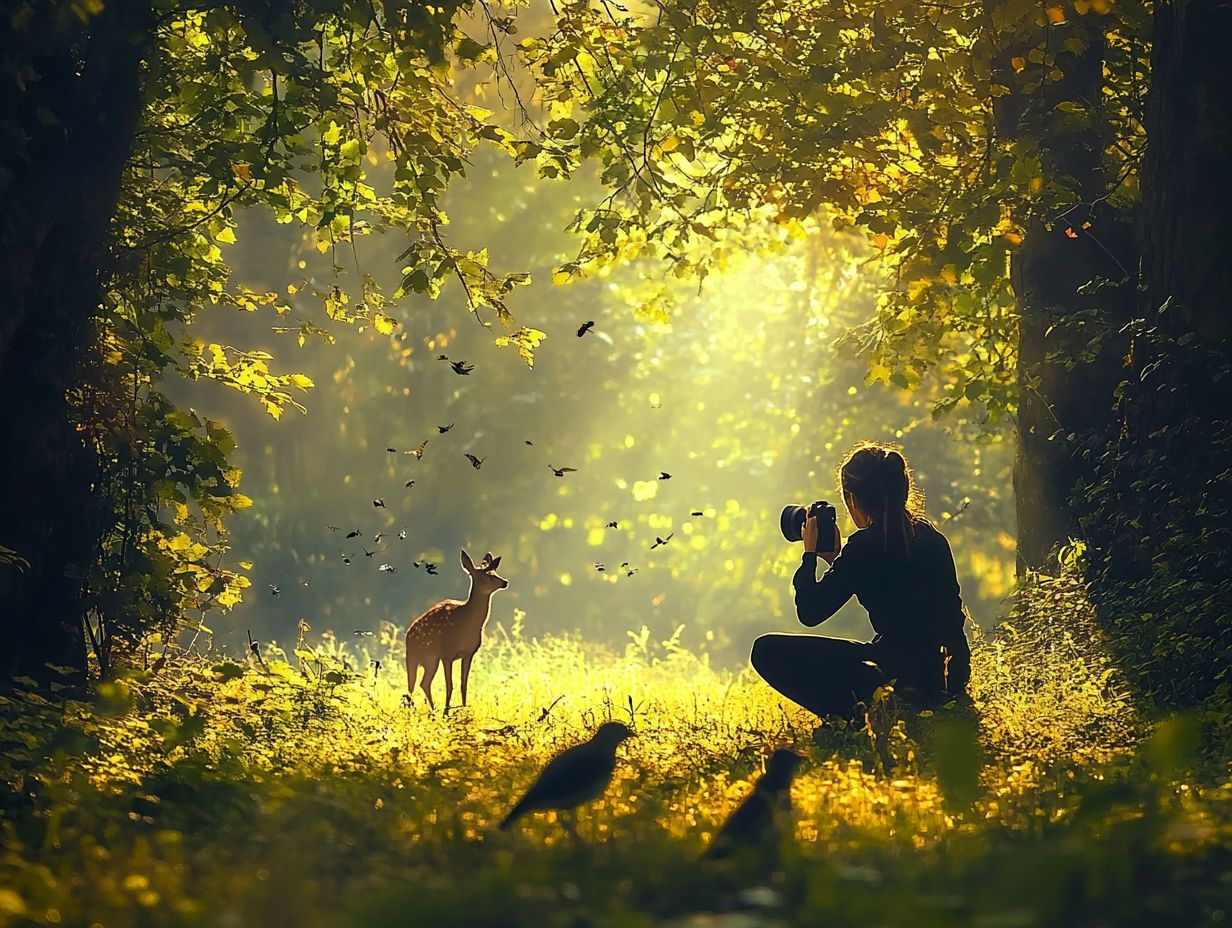
Capturing stunning shots in wildlife photography requires mastering techniques that elevate both the aesthetic and technical quality of your images, particularly composition and lighting.
Effectively utilizing exposure compensation balances highlights and shadows, ensuring your subjects stand out beautifully against their backgrounds. This is important whether you’re working in the enchanting glow of the Golden Hour or under the unforgiving brightness of the midday sun.
Composition and Framing
Composition and framing are essential elements in wildlife photography that can significantly enhance the storytelling aspect of your images. Capturing eye-level shots of animal interactions in their natural habitats helps craft compelling narratives. For instance, a moose gracefully crossing a river or playful polar bears frolicking in the snow creates an immersive experience for viewers.
Utilizing techniques like the rule of thirds guides the viewer’s eye to the focal points of action. Leading lines can accentuate an animal’s movement through its environment, adding a dynamic flair to your photographs. A shot of a cheetah sprinting across the savannah becomes far more impactful when framed within the natural lines of the grass, evoking a sense of speed and urgency.
Incorporating natural elements to frame your subject provides essential context, helping the image resonate emotionally with your audience. This approach allows them to forge a deeper connection with the wildlife and their surroundings, elevating your photography to new heights.
Get out there and start practicing these techniques today!
Lighting and Exposure
Mastering lighting and exposure is crucial for your wildlife photography journey, as varying lighting conditions can dramatically influence image quality. It will also dictate your choices for shutter speed and ISO sensitivity. You’ll find that the quest for the perfect light often leads you to the enchanting hours of dawn or dusk, known as the Golden Hour. It’s during these magical moments that you can capture the vibrant hues of nature while ensuring your subjects are beautifully exposed.
Navigating challenging lighting scenarios whether it s the harsh midday sun, overcast skies, or the mysterious twilight demands a keen understanding of how to adjust your settings for optimal results. For instance, when the sun is blazing, you can freeze motion by cranking up your shutter speed and reducing the camera’s sensitivity to light to keep things crisp and clear. In dim lighting, you’ll want to boost the camera’s sensitivity to light and lower your shutter speed, but don’t forget to employ stabilization techniques to fend off blur.
Pay attention to these variables. They will elevate your wildlife imagery and help you adapt to changing environments.
Locations and Timing for Wildlife Photography
Understanding the best locations and timing for wildlife photography can greatly enhance your ability to capture breathtaking images. Certain weather conditions and insights into animal behavior will significantly boost your chances of success.
Dive into the lush forests of New Hampshire or the vibrant suburbs where urban wildlife flourishes! Each environment presents distinct opportunities for you to document the beauty of nature, utilizing local knowledge to enhance your success.
Best Places to Photograph Wildlife
Some of the finest places to photograph wildlife include both remote natural parks and vibrant urban settings where wildlife flourishes. Resources like eBird.org can be invaluable for pinpointing local species and optimal locations, whether you re aiming to capture an elk in the wild or observe birds flitting around your backyard.
Locations such as Yellowstone National Park and the Everglades offer breathtaking backdrops enriched with diverse ecosystems, perfect for capturing the intricate behaviors of animals in their natural habitats. Each park boasts its own unique flora and fauna, from the iconic bison wandering through rolling meadows to the elusive alligators lurking in murky waters.
Urban areas like Central Park unveil hidden wildlife gems, revealing species that have adapted to city life. By engaging with local wildlife organizations and social media groups, you can glean insights into the best times and spots to enhance your chances of securing incredible shots. Join your local wildlife group today and discover the wonders in your backyard!
Optimal Times for Shooting
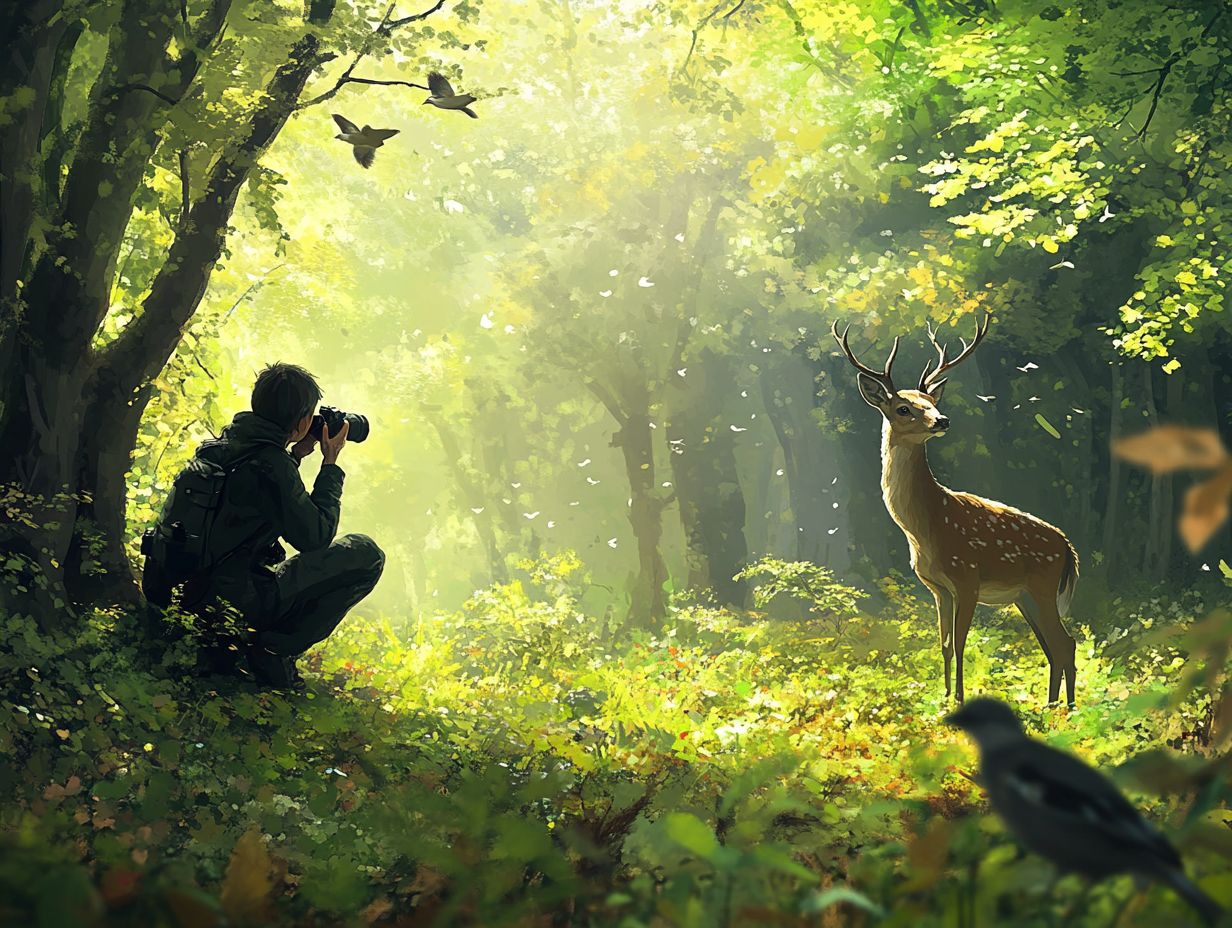
Determining the optimal times for shooting wildlife photography is essential for you, as different species display varied behaviors throughout the day. Patience and careful planning around weather conditions are key. Early mornings and late afternoons often offer the best light and heightened animal activity, creating opportunities to capture dynamic moments.
During these golden hours, the soft glow of the rising or setting sun enhances the natural beauty of animals and their surroundings, providing a visually stunning backdrop. The cooler temperatures of the early hours encourage many creatures to be more active and visible, engaging in critical behaviors like foraging or socializing.
Equally important is your understanding of how weather conditions influence wildlife. Overcast days may cast subdued light but can encourage animals to roam more freely, while rain often leads to fewer sightings. By incorporating these elements into your planning scouting locations and familiarizing yourself with animal patterns you significantly increase your chances of encountering wildlife at their most vibrant.
Tips for Getting Close to Wildlife
Approaching wildlife demands a refined blend of skills for being in the field with wildlife, an astute understanding of animal behavior, and a generous helping of patience. This powerful trio helps you snap stunning shots without intruding on your subjects.
Whether you find yourself navigating through thick underbrush or sitting silently beside a waterhole, mastering these skills is crucial for achieving success in wildlife photography.
Behavior and Safety Considerations
Understanding animal behavior is essential, not just for capturing breathtaking wildlife photographs, but also for safeguarding both yourself and the creatures you admire. Mastering fieldcraft skills allows you to anticipate movements and recognize signs of distress, which are vital for maintaining a respectful distance and steering clear of potentially dangerous encounters.
By paying attention to key behavior patterns like feeding habits, social structures, and seasonal migrations, you can more effectively predict where and when to position yourself for those perfect shots. For instance, if you know that certain birds are early risers, you can plan your photography sessions for dawn. Keeping a low profile and utilizing natural cover will help you avoid startling animals, ensuring their behaviors are captured authentically.
Being mindful of the ethical considerations surrounding wildlife interactions like not disturbing nesting sites or mating rituals is crucial for promoting conservation and respect for these magnificent beings. Always prioritize the well-being of wildlife, as this not only enhances your photography experience but also deepens your connection with the natural world.
Using Camouflage and Other Tactics
Using effective camouflage and tactical approaches can significantly elevate your wildlife photography. By blending seamlessly into your surroundings, you minimize disturbances to the animals, allowing for more authentic and impactful images. Whether it s natural materials or specialized clothing, these strategies become invaluable tools in refining your fieldcraft skills.
Consider the environment you find yourself in; opting for earth-toned clothing and leveraging natural features for concealment can work wonders. Strategic positioning is key staying low behind shrubs or using trees as cover can dramatically enhance your chances of capturing that perfect shot.
Patience is another essential ingredient. Remaining still for extended periods allows wildlife to acclimate to your presence. Think about setting up near a water source at dawn or dusk those magical times when animals are most active this can lead to remarkable photographic opportunities.
Using scents and calls can attract elusive species without raising alarm, further boosting your ability to secure stunning shots.
Frequently Asked Questions
What is wildlife photography?
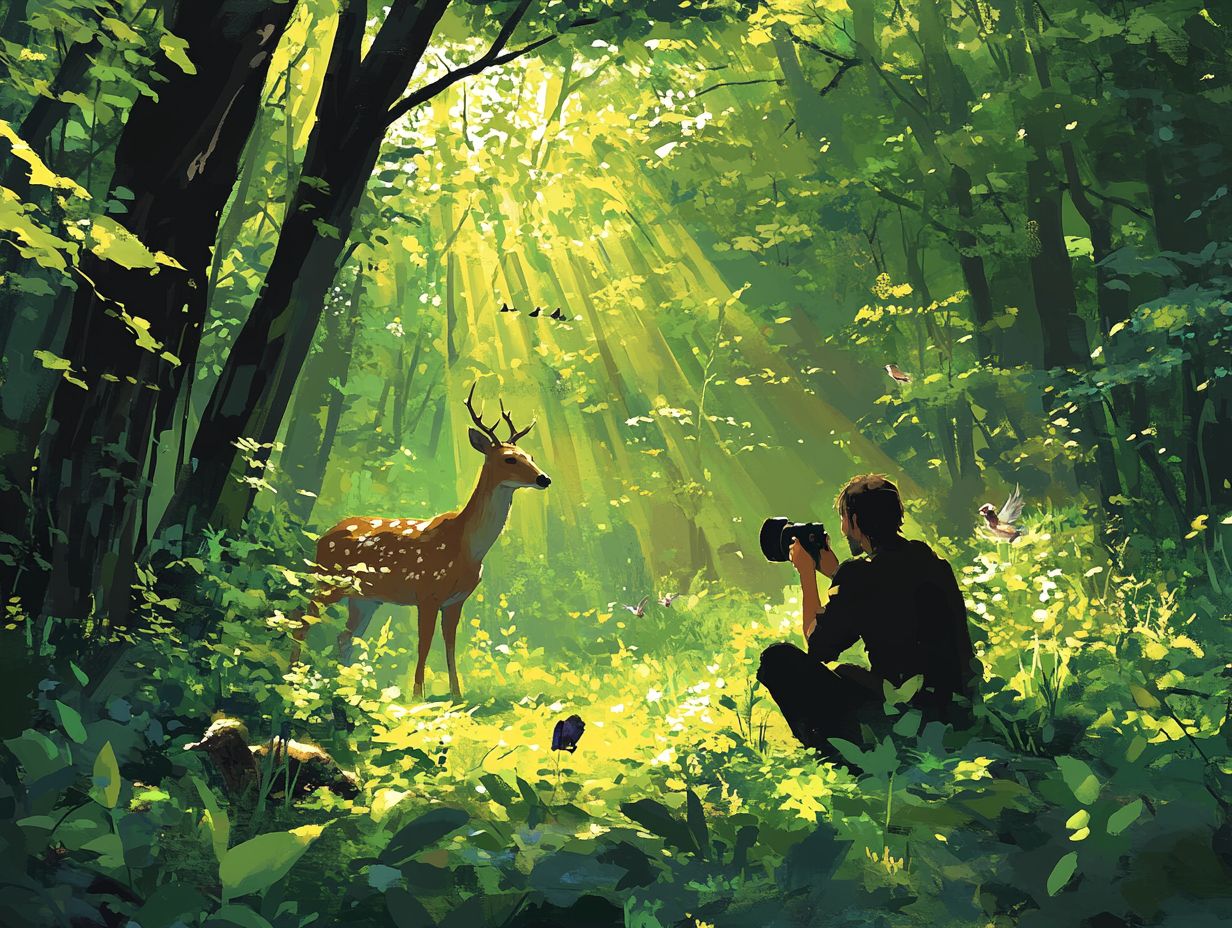
Wildlife photography is the practice of capturing images of animals in their natural habitat. It requires a certain set of skills and techniques to capture the essence of the animal and its behavior.
What are some tips for beginners in wildlife photography?
- Research and understand the behavior of the animal.
- Use the appropriate equipment.
- Practice patience and perseverance.
What equipment do I need for wildlife photography?
The most essential equipment for wildlife photography includes a telephoto lens (a camera lens that can zoom in on distant subjects), a tripod, and a camera with a high frame rate and fast shutter speed. Other useful equipment includes a bean bag or monopod for stabilization and a camouflage cover for blending into the environment.
How important is patience in wildlife photography?
Patience is crucial in wildlife photography, as it may take hours or even days to capture the perfect shot. It is important to observe and wait for the right moment to capture the animal’s behavior or movement.
What are some techniques for capturing great wildlife photographs?
- Use natural light.
- Get down to the animal’s eye level.
- Fill the frame with the subject.
- Use the rule of thirds for composition.
Get outside and start photographing wildlife! Embrace the thrill of wildlife photography!
Is it ethical to manipulate wildlife for a photograph?
Capturing wildlife in photos is thrilling, but we must ask ourselves: is it ethical? It is not ethical to manipulate wildlife for a photograph. As people who take pictures, we must respect animals’ natural behaviors.
Disturbing or harming them for a picture is unacceptable. We have a responsibility to protect wildlife and their habitats.

